Unmarked. Involving the US in the Vietnam War and the role of old bombers
But then, in Europe, the aircraft already showed themselves, on the contrary, well. After the war, these cars, retrained in the bombers with the new name B-26 and reconnaissance RB-26, remained in service and in 1950 on a large scale successfully proved themselves in Korea. The Korean War ended for the United States in 1953, and as it seemed to many in the Air Force, the era of piston bombers could be closed. And indeed, the "invaders" took their place in all sorts of second-rate and auxiliary units, the National Guard of various states, or simply appeared in storage. They were in large quantities sold or transferred to US allies. It seemed that in a rocket-atomic age, a machine that was not just designed at the beginning of the forties, but all of the copies that existed were still worn out, there was no future.
Of course, on these planes, various American allies continued to fight en masse - from the Batista regime to the French in Indochina, but the US Air Force, who had embarked on high-tech equipment, seemed to bid farewell to curiosities forever.
However, in the end everything turned out differently.
In 1950, the CIA formed detachments of mercenary pilots whose task it was to support anti-communist forces in Southeast Asia. These groups existed under the guise of the fictitious airline "Air America" and were actively used by the Americans in covert operations. At first, Laos was the main point of US efforts, but Vietnam after 1954, when two legitimate states appeared in its place (South Vietnam’s legitimacy was in question, but when did it stop the United States?) Also caused concern to Americans. In the 1961 year, when the success of the communist rebels could no longer be denied, the United States decided to strike. While secret.
On March 13, 1961, US President John F. Kennedy approved the OKNS plan to secretly use combat against the rebels in Laos. Aviation. Thus began the operation "Millpond" (translated as a pond at a water mill). Over the next forty days, small aviation forces were deployed to Thailand at Tahli Base. Pilots were recruited in all types of the US Armed Forces, as well as among the CIA mercenary pilots. The group included 16 Invader bombers, 14 Sikorsky H-34 helicopters, three S-47 transport vehicles and one four-engine DC-4.
It was planned that while the Thai military, using artillery and advisers, would help Lao royalists on the ground, the mercenaries on the planes would strike at the socialist rebels, as well as provide reconnaissance and air transportation.
The operation, however, did not take place - and the CIA on the other side of the planet urgently needed airplanes and pilots in Cuba, to which the United States had planned to launch an invasion of mercenaries. And unlike Laos, there the “twenty-sixth” had to make war, and the same aircraft were on the Cuban side.
Select B-26 as weapons Covert operations were due to a variety of reasons. First, these planes were available in large quantities. Secondly, they were not worth much money. Thirdly, there were no problems in finding or training pilots for them, and providing airfield services. And fourthly, in the absence of an enemy air defense and fighter aircraft, the Invaders were a formidable tool capable of bringing several tons of napalm tanks, bombs, unguided rockets or thousands of 12,7 caliber of millimeters to the ground — in the nose of the aircraft it was already installed eight of these machine guns, and besides them, a suspension was possible under the wings. According to the experience of the Second World War, it was known that such flying machine gun batteries possessed crushing force.
And, which was also very important, the plane allowed pilots to detect small targets in flight. Just in those years, the US Air Force struck in preparation for a nuclear war, in the creation of high-speed supersonic strike aircraft capable of carrying tactical nuclear weapons. Such machines were the exact opposite of what was needed when striking an enemy dispersed in the jungle, whereas a piston drummer with a straight wing was much better suited for such tasks.
The Vietnam War turned out to be the largest failure of the US Air Force in terms of technical policy - unlike the Navy, right from the very beginning of the war, who had a light attack aircraft A-4 "Skyhawk" and later received very successful A-6 "Intruder" and A- 7 "Corsair-2", the Air Force was not honored to create a powerful strike aircraft, applicable in Vietnam to perform tasks for the direct support of the troops. Therefore, the use of old piston aircraft for the Air Force until a certain point turned out to be the only alternative.
Another factor was the international ban on the supply of jet planes to Vietnam from 1954. Piston under this ban did not fall.
Finally, the use of B-26 made it possible to hope for secrecy of operations — there were quite a few such aircraft in the world, the US sold them to various countries, and their use always allowed them to disclaim responsibility for the consequences of the bombings.
Although the operation "Millpond" and de facto did not take place, "Inweider" was soon to arrive nevertheless in Southeast Asia. This time - to Vietnam.
Almost immediately after the start of Operation Millpond, and even before it was completed, Kennedy signed the so-called National Security Action Memorandum (NSAM) 2 number, which required the creation of forces capable of withstanding supported by the USSR and Northern Vietnam Viet Cong rebels. As part of this assignment, General of the US Air Force Curtis Le Mey, the “icon” of the American strategic bombardments of World War II, which by then had occupied the post of Deputy Chief of Staff of the Air Force, ordered the Air Force Tactical Command to create an elite unit capable of providing air assistance to South Vietnam.
Thus began the operation "Farm Gate" (translated as "Farm Gate" or "Entry to the farm").
14 April 1961, the Tactical Command created a new unit - “Combat Crew Training Squadron No. 4400” (4400th Combat Crew Training Squadron (CCTS)). It includes the 352 man, including the 124 officer. The commander was selected personally by Le May, Colonel Benjamin King, a WWII veteran with a great deal of combat experience. The whole staff consisted of volunteers. At the same time, although formally the tasks included training South Vietnamese pilots, King was directly instructed to prepare for military operations. In the American documents required for taking the squadron for supply, she received the code name "Jim from the jungle" - "Jungle Jim". A little later, it became the nickname of the squadron.
The squadron received the C-47 transport aircraft in the search and rescue version of the SC-47 in the number of 16 units; piston combat training aircraft T-28, in the number of 8 units, and also eight B-26 bombers. All aircraft had to fly with the identification marks of the Air Force of South Vietnam. Squadron soldiers flew on missions in uniform without insignia, emblems and without documents. Such secrecy was due to the reluctance of Americans to demonstrate their direct participation in the Vietnam War.
Everyone who was accepted into the squadron was asked whether the newcomer agreed that he could not act on behalf of the United States, wear an American uniform, and that the US government would have the right to abandon it when taken prisoner with all the ensuing consequences. ? In order to join the ranks of the new division, it was necessary to agree with it in advance.
It was announced to the personnel that their squadron would be deployed as part of special operations forces, and that it would be classified as “air commandos”. This was followed by a series of exercises to perform percussion tasks, including night ones, as well as tasks for the transfer and fire support of army special forces.
In terms of where it is planned to fight, complete secrecy was observed: all personnel were convinced that this was an invasion of Cuba.
October 11 1961 in NSAM 104 Kennedy ordered to send a squadron to Vietnam. The air commando war has begun.
They were to arrive at Bien Hoa airbase, 32 kilometers north of Saigon. It was a former French airfield, which was in disrepair. The first air commando squadron arrived in Bien Hoa in November with SC-47 and T-28 aircraft. The second group on the B-26 bombers arrived in December 1961 of the year. All aircraft were marked identification marks of the South Vietnamese Air Force.
The staff and the pilots soon began wearing non-stats Panamas, similar to Australian ones, as uniforms. This was worn even by Colonel King.
On December 26, US Secretary of Defense Robert McNamara, who noted an extremely ominous role in initiating and waging this war, issued an order stating that the South Vietnamese cadet should be on board all American flights. This was done initially, but no one taught the Vietnamese anything. However, they were taken for cover, since the squadron was formally training. A little later, the Americans actually started the learning process too, but from the very beginning the actual tasks were completely different and the Vietnamese on board were nothing more than a cover. One of the commanders of SC-47, captain Bill Brown, explicitly stated in private conversations after returning from Vietnam that his Vietnamese “passengers” were expressly forbidden to touch any of the aircraft's controls.
The training flights of the “air commandos” began from the end of 1961. B-26 and T-28 performed reconnaissance, air patrol and surveillance missions, and direct ground support. SC-47 began conducting psychological operations - scattering flyers, propaganda broadcasting with the help of loudspeakers on board. They also performed the task of transporting US special forces engaged in the preparation of anti-Viet Cong irregular paramilitary forces, whose number grew rapidly at that time.
With the start of 1962, King was ordered to move to overnight operations in order to maintain secrecy. On the one hand, the available aircraft were not adapted for this - in general. On the other hand, King had a great experience of such operations and he knew how to perform them. Soon all the crews began to receive special night training. Soon, night combat flights began.
The standard tactics of night attacks for “air commandos” were to drop missiles from the suspension units or from the SC-47 doors, and the subsequent attack of targets detected by the light of the missiles — as a rule, Viet Cong fighters. However, according to the Americans, the latter often scattered right away, as soon as the Americans "turned on the light" - lightly armed partisans could not oppose the planes, and flight was the only sane decision.
There were, however, many exceptions. The Vietnamese often shot back, and the combat missions of the “training squadron” could not be called light.
Over time, instead of lighting flares, napalm began to be used. Nevertheless, as noted by American researchers, such a primitive tactic made attacks possible only thanks to the extremely high crew training.
From the beginning of 1962 of the year, the Jim from the Jungle group was subordinated to the command of the 2 Division of the United States Air Force, in which it was the only combat unit - officially America did not participate in the war. The division commander, Brigadier Rollin Entsis, saw that the ground forces of South Vietnam could not cope with the Viet Cong without air support, and the South Vietnamese air forces themselves could not cope with this task due to the low level of pilots and small numbers. The work of the "air commandos" became more and more intensive, for them advanced airfields were equipped closer to the front line, but they lacked strength.
Entsis asked for reinforcements for the "air commandos" and the possibility of their wider use in hostilities. In the second half of 1962, he also asked for 10 B-26, 5 T-28 and 2 SC-47. The request was considered personally by McNamara, who was very cool about him, since he categorically did not want the expansion of the American military presence in Vietnam, expecting that it would be possible to prepare local forces capable of fighting, but as a result, permission was given to these planes , and a couple of light-engine U-10 for communication and surveillance.
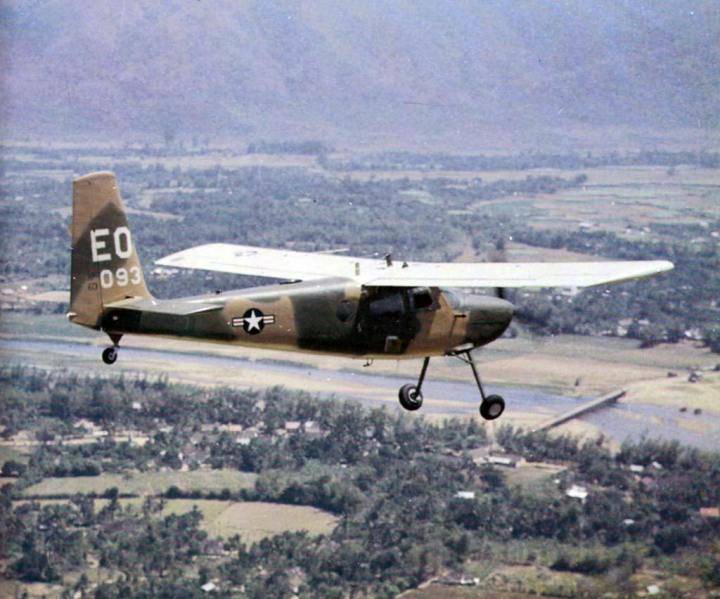
The beginning of 1963 of the year was marked by several major military defeats suffered by the South Vietnamese forces from the Viet Cong. It became clear to American commanders and politicians that the Vietnamese themselves would not fight for the Saigon regime. Gain needed.
By that time, the total number of US Air Force personnel in Vietnam had exceeded 5000 people, of whom mostly “air commandos” still fought. Under these conditions, the United States Air Force stopped hiding so much, and formed a new division - 1st Air Commando Squadron - 1-th Air Commando Squadron. The entire flight and technical staff, airplanes and military equipment for the new part were taken from squadron No. XXUMX, for which nothing really changed except the scale of the combat missions. The squadron itself 4400 continued to exist as a training unit in the United States.
The intensity of the struggle by that time was seriously aggravated. The Vietnamese no longer feared aircraft, had heavy DShK machine guns, both Soviet and Chinese, and successfully used them. The first loss of the “commandos” was sustained back in February of 1962 — the SC-47 was shot down from the ground by fire, discharging cargo on a parachute. Six American pilots, two soldiers and one South Vietnamese soldier were killed.
As the scale of hostilities grew, so did the losses. By July 1963 of the year, 4 B-26, 4 T-28, 1 SC-47 and 1 U-10 were lost. The casualties were 16 people.
A separate description deserves a technique on which the Americans had to fight. All aircraft constructively related to the types used during the Second World War. Moreover, B-26 participated in this war directly, and then fought in Korea and other places. After that, they were stored for a long time at the Davis-Montana Air Force storage facility. Despite the fact that before entering the squadron, the aircraft underwent repairs, their condition was terrible.
Here is how one pilot, Roy Dalton, who was then captain of the Air Force and piloted the B-26, described it:
The equipment was primitive, the communication in the cockpits sometimes did not work, and the navigators had a worked out set of signals in the form of pilot's pops on the back.
Once, B-26, which the CIA had previously used in its clandestine operations in Indonesia, were delivered as reinforcements to the squadron. These aircraft were in even worse condition and have not been repaired ever since 1957.
As a result, the B-26 combat readiness ratio never exceeded 54,5%, and this was considered to be a good indicator. At the beginning of the operation, the Air Force naturally swept away all the warehouses with spare parts for B-26, sending a huge stock of them to Vietnam. Only thanks to this aircraft could fly.
Dalton gives a list of faults of his aircraft for one of the periods of participation in hostilities in 1962:
16 August - the bombs in the bomb bay did not come off.
20 August - the bombs in the bomb bay did not come off.
22 August - the loss of fuel pressure in the pressure pipe of one of the engines.
22 August - another engine gives claps to the inlet during abrupt work with "gas".
22 August - biting movement of the steering wheel when moving "on itself".
September 2 - the missiles did not launch.
5 September - the failure of the radio station to communicate with the "land".
September 20 - spontaneous dropping of bombs at the opening of a bomb bay.
September 26 - brake pipe rupture during landing.
28 September - engine failure when leaving the attack.
September 30 - brake failure during landing.
October 2 - failure of the magneto of the left engine when taxiing.
October 7 - leakage from the brake mechanism of one of the wheels during a takeoff run.
October 7 - failure of the generator of the right engine.
October 7 - the failure of two machine guns.
October 7 - engine failure at the exit from the attack.
It is difficult to imagine, but they flew in this mode for years.
However, some of the aircraft before delivery to Vietnam received a fully-fledged repair and did not deliver such problems to the crews. Also of interest is the fact that one of the scouts RВ-26 received the so-called infrared mapping system. It looked quite exotic on an airplane, the first prototype of which took off as early as 1942, and also did not work very well, however, it was used in night operations to monitor the terrain and detect Vietcong boats. The aircraft received the index RB-26L.
Nevertheless, the age took his own. Back in 1962, overload sensors were installed on all B-26 so that pilots could monitor the load on the fuselage. 16 August 1963, one of the aircraft in the course of the combat mission began to collapse wing. The pilots managed to escape, but the plane was lost.
And 11 February 1964 of the year, in the United States at the Eglin Air Force Base, during the demonstration of the "counterguerrilla" capabilities of the B-26 aircraft, the left wing fell away in flight. The reason was the impact of recoil from firing wing machine guns. The pilots died. At that moment, one of the B-26 "air commandos" was in the air in Vietnam. Pilots received orders to return immediately. Flights In-26 then stopped.
After checking the existing aircraft in the ranks, the Air Force decided to simultaneously remove from service all non-upgraded B-26. The exceptions were B-26K only.
This modification, made by On Mark Engineering, turned the old B-26 into a completely new car. The list of changes made to its design is very impressive.And, it must be admitted that the combat effectiveness of the aircraft has grown quite proportionally to the investments in its modernization, as well as reliability. But there were no such planes at the beginning of the 1964 year in Vietnam, and when the 1 th air squadron "commando" put its B-26 "stuck", its work stood for a while. B-26K appeared on this war later, and they had to fly from Thailand, attacking trucks on the Ho Chi Minh Trail. But it will be later with other parts of the Air Force.
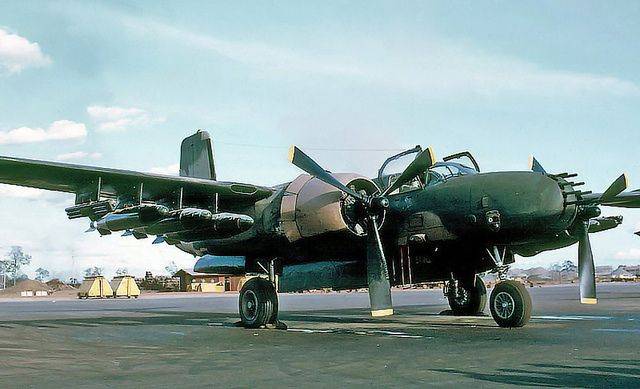
Together with the B-26 1 squadron had to stop using part of the T-28, for the same reasons - the destruction of the wing elements. In fact, now the squadron's work was limited to flights of transport and rescue SC-47. I must say that they sometimes achieved outstanding results by finding platforms for landing right under Vietnamese fire, in bad weather, at night, and pulling out American and South Vietnamese fighters right from under the shelling - and this with primitive equipment that has not changed since the Second World War!
However, towards the end of 1964, their flights were also stopped, and in December, the “air commandos” received a weapon with which they would go through the entire Vietnam War - A-1 Skyraider single-engine piston attack aircraft. It was also the 1 air command squadron that set up the first American experiments with a new class of aircraft, the ganship, a transport plane with rifle-gun armament installed on board. The AU-47 Spooky became their first "Gipships", and closer to the end of the war, they managed to fly the AU-130 Specter.
However, mostly "air commandos" fought on "Skyraders". Escorting rescue helicopters and protecting downed pilots until the rescuers arrived added to their usual tasks later. September 20 squadron was redeployed to Thailand, at the Nakhon Fan air base. From there, the squadron worked along the “Ho Chi Minh trail”, trying to stop the supply of the Viet Cong from North Vietnam. 1 August 1968, the squadron got its modern name - 1-I squadron of special operations, under which it still exists.
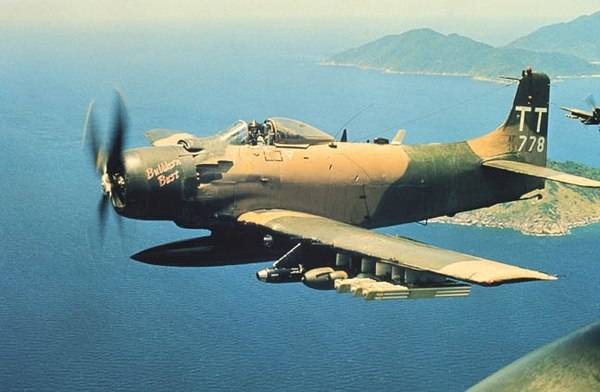
But it was already a completely different story - after the Tonkin incident, the US entered the war openly, and the activity of the "air commandos" was just one of the factors of this war. Not the most important. In addition, it finally became possible for them not to hide and to put identification marks on the USAF on their aircraft. However, even after that, their Skyraders flew for quite a long time without any identifying marks at all.
The history of the 1 Squadron is the starting point from which the modern units of the special-purpose air force, which are used during special operations, lead their “lineage”. And the operation “Farm Gate” for Americans is the first step into the abyss of the ten-year Vietnamese war. And all the more surprising is the role played by the old bombers in all these events.
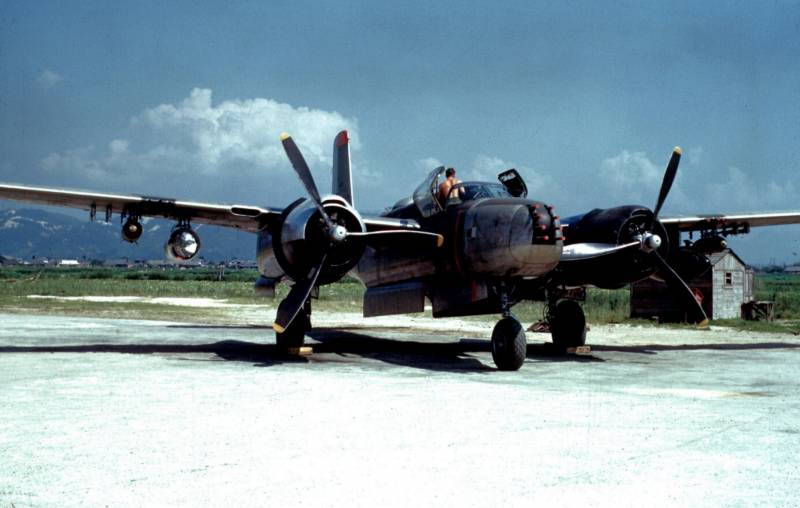
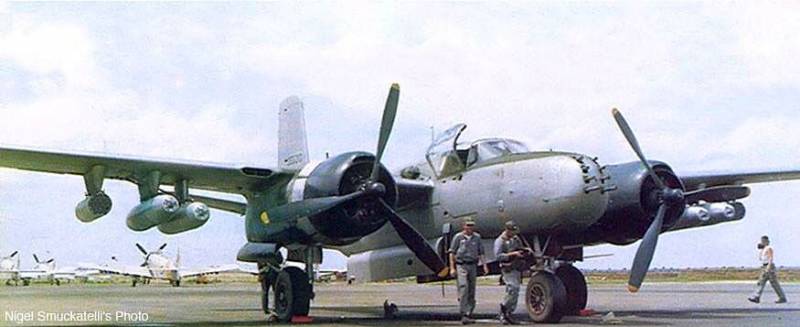
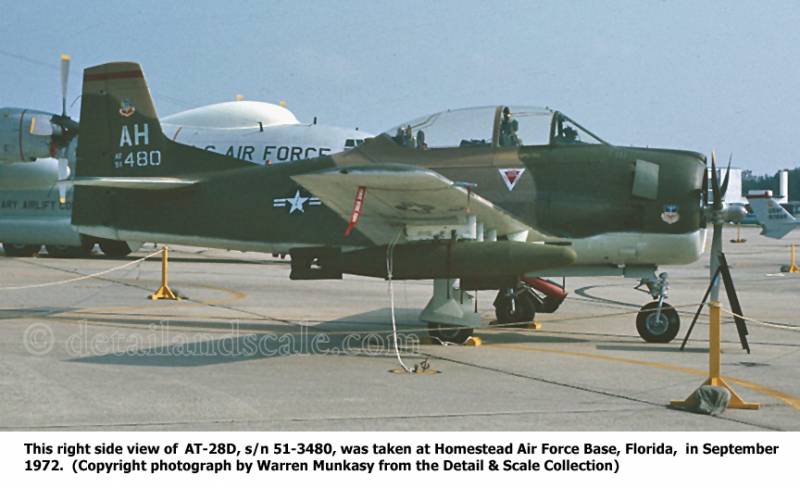
Information